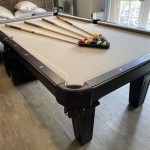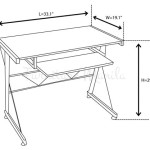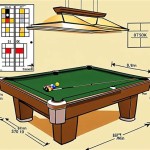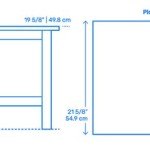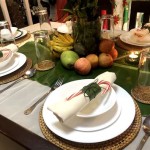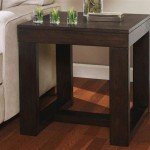DIY Wall-Mounted Drop-Down Laundry Folding Table
A wall-mounted, drop-down laundry folding table offers a practical solution for maximizing space in laundry rooms, apartments, or any area where surface space is limited. This type of table can be easily folded away when not in use, freeing up valuable floor space and maintaining a tidy environment. Constructing such a table is a manageable DIY project that can be completed with basic woodworking skills and readily available materials.
The primary advantage of a DIY approach is customization. The dimensions, materials, and overall design can be tailored to suit individual needs and preferences. This allows for the creation of a folding table that perfectly fits the available space and complements the existing décor. Furthermore, a DIY project offers cost savings compared to purchasing a pre-made, commercially available folding table. By sourcing materials and undertaking the construction process independently, individuals can significantly reduce the overall expense.
Planning and Design Considerations
Before commencing the construction process, careful planning and design are essential. The first step involves determining the optimal dimensions for the folding table. Consider the typical size of laundry loads and the available wall space. A table that is too small may be insufficient for handling large loads, while a table that is too large may be cumbersome and occupy excessive wall space. Measure the intended mounting location precisely, taking into account any obstructions such as electrical outlets, pipes, or door frames.
Next, select the appropriate materials. Plywood is a commonly used material for the tabletop due to its affordability, durability, and ease of workability. Hardwood, such as oak or maple, can be used for the frame and supporting structure to provide increased stability and strength. The thickness of the plywood and hardwood should be chosen based on the desired load-bearing capacity and the overall size of the table. Choosing materials with appropriate weight is important as this can either increase or reduce the likelihood of the folding table malfunctioning.
The folding mechanism is a critical component of the design. Hinges are typically used to allow the tabletop to pivot up and down. Heavy-duty hinges are recommended to ensure smooth operation and prevent sagging over time. Locking mechanisms, such as latches or magnetic catches, are necessary to secure the table in both the open and closed positions. These mechanisms prevent the table from accidentally collapsing or swinging open. Evaluate different latching systems carefully to ensure their durability and ease of use.
Consider incorporating additional features to enhance the functionality of the folding table. A built-in ironing board can be a valuable addition, providing a dedicated space for ironing clothes. Shelves or drawers can be integrated into the design to provide storage for laundry supplies, such as detergent, fabric softener, and ironing accessories. These extra features allow for a one stop station for laundry needs.
Construction Process
The construction process begins with cutting the plywood and hardwood to the required dimensions. Use a circular saw or a table saw to ensure accurate and clean cuts. Sand the edges of the plywood and hardwood to remove any splinters or rough spots. This will create a smooth surface for finishing and prevent injuries during use. It is important to have clean cuts so that when the folding table is used that it is stable.
Assemble the frame by joining the hardwood pieces using screws, nails, or wood glue. Ensure that the frame is square and level. The frame provides support for the tabletop and distributes the weight evenly. Reinforce the corners of the frame with corner braces for added strength and stability. Clamps are also a handy tool to make sure edges are as flush as possible while the adhesive cures properly.
Attach the hinges to the frame and the tabletop. Position the hinges carefully to ensure that the tabletop folds smoothly and evenly. Use screws that are appropriate for the thickness of the materials. Test the folding mechanism to ensure that it operates correctly. The alignment of the hinges is critical for proper functionality. If the hinges are even slightly off, this can cause problems when locking the folding table.
Install the locking mechanisms to secure the table in both the open and closed positions. Position the latches or magnetic catches strategically to prevent the table from accidentally collapsing or swinging open. Test the locking mechanisms to ensure that they function properly. There are many different types of latches, and it is important to find ones that match the decor of the desired room.
If incorporating additional features, such as an ironing board or shelves, install them according to the design plan. Ensure that these features are securely attached and do not interfere with the folding mechanism. The extra features should also be easily accessible when the folding table is open.
Once the construction is complete, apply a finish to the folding table to protect the wood and enhance its appearance. Use paint, stain, or varnish to achieve the desired look. Apply multiple coats of finish, allowing each coat to dry thoroughly before applying the next. Lightly sand between coats to create a smooth surface. Finishing helps to protect the wood from moisture and wear, extending the life of the folding table.
Installation and Mounting
The installation process involves securely mounting the folding table to the wall. Locate wall studs using a stud finder. Wall studs provide a solid anchor point for the mounting screws. Mark the location of the studs on the wall. If studs are not available at the desired location, consider using drywall anchors or molly bolts. Note that these may not be as durable as screws in studs.
Position the folding table against the wall, aligning the mounting holes with the marked stud locations. Use a level to ensure that the table is mounted horizontally. Drill pilot holes through the mounting holes and into the wall studs. This will make it easier to drive the screws and prevent the wood from splitting. Making pilot holes ensures that the material is not damaged during the mounting process.
Insert screws through the mounting holes and into the wall studs. Use screws that are long enough to penetrate the studs deeply and provide a secure hold. Tighten the screws securely, but avoid over-tightening, which can strip the threads or damage the wood. Ensuring the screws are securely mounted help prevent the folding table from slipping down the wall.
Test the stability of the mounted folding table. Apply weight to the tabletop to ensure that it can support the intended load. Check the folding mechanism to ensure that it operates smoothly and the locking mechanisms engage properly. Make any necessary adjustments to ensure that the table is secure and functional. Test the moving components of the folding table to ensure smooth operation after installation.
Finally, conceal the mounting hardware with decorative caps or covers to create a clean and professional look. This will enhance the aesthetics of the folding table and prevent anyone from accidentally snagging their clothing on the screws. Once all of these steps are complete, the DIY wall-mounted drop-down laundry folding table is ready for use. As a final precaution, test the sturdiness of the table one final time to ensure there are no issues with operation.

Diy Drop Down Laundry Table Creative Housewives

Diy Drop Down Laundry Table Creative Housewives

How To Build A Collapsible Laundry Room Folding Table Diy Tables Storage

Diy Drop Down Laundry Table Creative Housewives

Diy Fold Down Laundry Table Www Housewivesofriverton Com Room Folding Makeover

Diy Drop Down Laundry Table

Home Dzine Diy Fold Up Drop Down Table

Need Small Fold Down Wall Mounted Workbench Heavy Duty Folding Table Length 47 2 Width 20 Perfect Addition To Garage Laundry Home Bar Kitchen Din Room Diy Walls

The Best Diy Laundry Room Folding Station With Drying Racks

Space Saving Laundry Room Table

